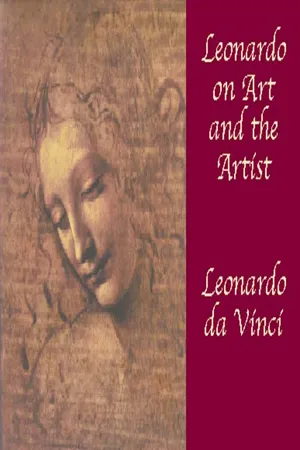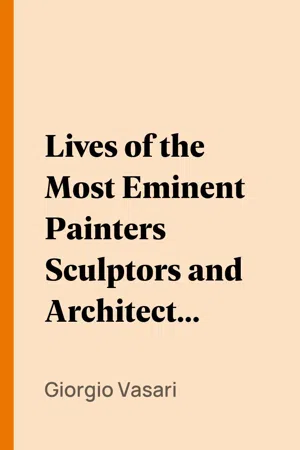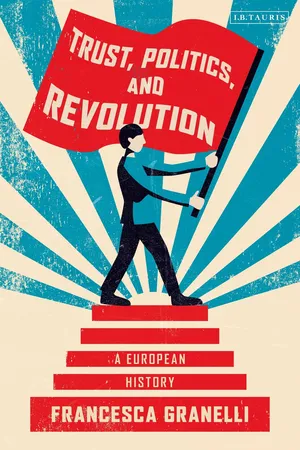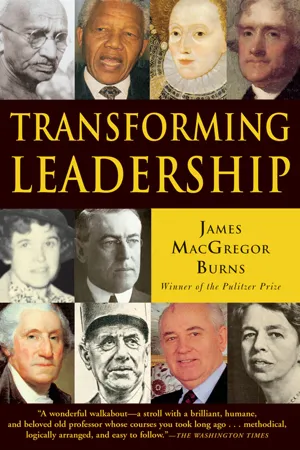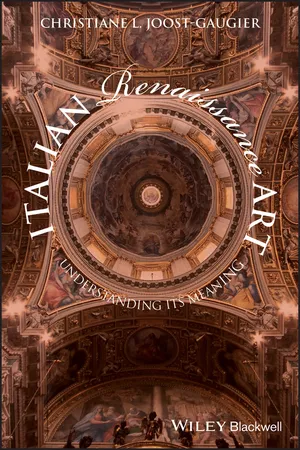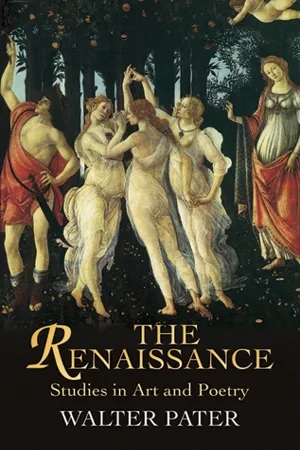History
Leonardo Da Vinci
Leonardo da Vinci was a renowned Italian polymath of the Renaissance era, known for his expertise in various fields including painting, science, engineering, and anatomy. He is celebrated for iconic works such as the Mona Lisa and The Last Supper, as well as his innovative designs and scientific observations. Da Vinci's legacy continues to inspire and influence art, science, and innovation.
Written by Perlego with AI-assistance
Related key terms
7 Key excerpts on "Leonardo Da Vinci"
- eBook - ePub
- Leonardo da Vinci(Author)
- 2012(Publication Date)
- Dover Publications(Publisher)
Three Biographies of Leonardo
Vasari’s Life of Leonardo Da Vinci is one of that famous Florentine historian’s finest biographies. First published in 1550 (the second edition of 1568 has important corrections and variations), it has by now achieved a position of authority and contrasts favorably with the innumerable romanticized biographies Leonardo’s personality inspired during the last one hundred years. Nonetheless, it is worthwhile to consider two shorter texts in conjunction with it. One was written about 1527 by the humanist Paolo Giovio (1483-1552).The other is included in the lives of illustrious men compiled by the so-called Anonimo Gaddiano, an unidentified Tuscan who, despite some errors and a particularly confused chronology, does supply valuable additions to Leonardo’s oeuvre. These three works, at times inexact and even contradictory, constitute the early record of the artist and as such it is well to keep them in mind.THE LIFE OF Leonardo Da Vinci BY PAOLO GIOVIO *
Leonardo, born in the little Tuscan village of Vinci, added greatly to the glory of the art of painting for he established that this art could only be practiced successfully by those conversant with the sciences and the higher disciplines, which he considered its indispensable aids. He placed modeling before brush work as the order to follow in the development of a painting. According to him, nothing is of greater importance than the rules of optics for they permit him to distribute light and to utilize the laws of shade with great care down to the smallest detail. Furthermore, he learned to dissect the corpses of criminals in the schools of medicine, despite the inhuman and disgusting nature of this work, in order to paint the bending and stretching of the different members according to the action of the muscles and the natural articulation of the joints. That is why, with admirable care, he recorded the shapes of all the elements down to the smallest vein and the insides of the bones on metal so that by means of prints the product of many years’ work should become known through innumerable copies for the benefit of art. - eBook - ePub
Lives of the Most Eminent Painters Sculptors and Architects, Vol. 04 (of 10)
Filippino Lippi to Domenico Puligo
- Giorgio Vasari(Author)
- 2009(Publication Date)
- Perlego(Publisher)
But the fact that they have to grapple more with famine than with fame, keeps our hapless intellects submerged, and, to the shame and disgrace of those who could raise them up but give no thought to it, prevents them from becoming known. And let this be enough to have said on this subject; for it is now time to return to the Lives, and to treat in detail of all those who have executed famous works in this third manner, the creator of which was Leonardo Da Vinci, with whom we will now begin. Leonardo Da Vinci LIFE OF Leonardo Da Vinci [10] PAINTER AND SCULPTOR OF FLORENCE The greatest gifts are often seen, in the course of nature, rained by celestial influences on human creatures; and sometimes, in supernatural fashion, beauty, grace, and talent are united beyond measure in one single person, in a manner that to whatever such an one turns his attention, his every action is so divine, that, surpassing all other men, it makes itself clearly known as a thing bestowed by God (as it is), and not acquired by human art. This was seen by all mankind in Leonardo Da Vinci, in whom, besides a beauty of body never sufficiently extolled, there was an infinite grace in all his actions; and so great was his genius, and such its growth, that to whatever difficulties he turned his mind, he solved them with ease. In him was great bodily strength, joined to dexterity, with a spirit and courage ever royal and magnanimous; and the fame of his name so increased, that not only in his lifetime was he held in esteem, but his reputation became even greater among posterity after his death. Truly marvellous and celestial was Leonardo, the son of Ser Piero da Vinci; and in learning and in the rudiments of letters he would have made great proficience, if he had not been so variable and unstable, for he set himself to learn many things, and then, after having begun them, abandoned them - eBook - ePub
Edison's Concrete Piano
Flying Tanks, Six-Nippled Sheep, Walk-on-Water Shoes, and 12 Other Flops from Great Inventors
- Judy Wearing(Author)
- 2009(Publication Date)
- ECW Press(Publisher)
THE HISTORIC AGE
Passage contains an image
UNDERSTAND PHYSICS
Leonardo Da Vinci'S WALK-ON-WATER SHOES
1452–1519This drawing of a soldier walking on water is found in the Codex Atlanticus, one of da Vinci's notebooks.From obscure beginnings in a small town in Italy over 500 years ago, Leonardo Da Vinci has become one of the most famous individuals in the history of Western civilization. His great work, the Mona Lisa , is the single most visited painting in the world; it also holds the record for the painting most subjected to vandalism. Whether fan or critic of this enigmatic figure, da Vinci's power to affect people's emotions is undeniable. His first biographer, the Italian Giorgio Vasari, who was eight years old at the time of da Vinci's death, wrote of him, “celestial influences may shower extraordinary gifts on certain human beings, which is an effect of nature; but there is something supernatural in the accumulation in one individual of so much beauty, grace, and might.” The list of disciplines that have some claim to assess his accomplishments is long and includes art, geology, optics, anatomy, music, mathematics, botany, mechanics, general physics, astronomy, literature, theater, geography and cartography, graphics, engineering, architecture, hydraulics, and chemistry. And yet, despite his universally accepted genius and his timeless influence, da Vinci's life was full of failure at every turn. He is a paradox, as enshrouded in mystery and as intriguing by nature as Mona Lisa herself.Da Vinci was a homo universalis and presents a near perfect distilment of the quattrocento.[1]As a boy he was a classmate of Botticelli, and later he rubbed shoulders with Michelangelo in Florence, as well as many other artistic geniuses who sought to understand nature as a whole. He was also an illegitimate child, a product of a brief union between a peasant woman and a notary. Da Vinci's illegitimacy had a profound influence on his failures and successes throughout his life. He was taken from his mother's household and raised by his grandparents on their small farm, though it is speculated that he likely visited his mother and her subsequent family from time to time.[2] - eBook - ePub
Trust, Politics and Revolution
A European History
- Francesca Granelli(Author)
- 2019(Publication Date)
- I.B. Tauris(Publisher)
7 Renaissance Man – A revolutionary? Florentine Renaissance (1330–1550)A period of transition, the Renaissance is considered a bridge between the medieval period and modernity, traditionally defined as an era of discovery, both geographically and scientifically, of the world and of man.1 Witness to a variety of ‘revolutions’ across many disciplines (including the arts, science and technology, religion, learning and communication, philosophy and politics, trade and finance), this period in European history often experienced turbulent social and political upheaval.2 There was a decline in the influence of the Church while the value and agency of man were deified as classical learning was revisited in a milieu of historical infatuation. This period, however, was not strictly ‘rational’ or ‘secular’, (and neither did a full-blown individualism emerge), ‘instead, [it] is characterised by the uneasy co-existence between traditional themes and the plurality of new approaches.’3 Rather than a break with the past, the Renaissance, in many respects, is part of an ‘uninterrupted series of scarcely perceptible improvements’ towards modernity,4 with many of its achievements tracing their roots to the Middle Ages and cross-cultural interactions with the East.5 - eBook - ePub
- James MacGregor Burns(Author)
- 2007(Publication Date)
- Grove Press(Publisher)
wonders of the courts of Milan and France,” according to biographer Alessandro Vezzosi. Although not a professional soldier, he planned elaborate defensive fortifications and even sketched a crude submarine. Although not trained in architecture, he designed villas, arcades, churches, and citadels. He dreamed up a bridge 1,250 feet long to span Constantinople’s Golden Horn. He made sketches of clocks, looms, “wind machines.” Enamored of flight, he studied the action of birds to conceive a flying machine that flapped its wings. While he indulged in such fantasies as perpetual motion, his engineering plans alone would have made him famous.One might assume that the artist, engrossed in such a myriad of projects, would have little chance or inclination to step back and glimpse the “larger picture.” On the contrary, Leonardo thirsted for unity and synthesis. In map drawings he sought to combine the best knowledge of terrain with cosmology and the highest principles of aesthetics. He sought the underlying order in all he did, in ways of thinking about human anatomy, optics, mathematics, and about the ubiquity of change in nature that reflected his own mind’s restlessness. He came nearest to achieving his dream of unity in sublime paintings that, art historian James Ackerman wrote, fused “empirical observation, mathematical order, and imagination,” and even rose to the level of a natural philosophy in oils.How to explain Leonardo’s inexhaustible and prodigious creativity? He was born in a most artistically fertile region during the Renaissance in the fifteenth century. He grew up in a large, cosmopolitan, and nurturing family. He was mentored by leading teachers and artists of the day, most notably the painter and sculptor Andrea del Verrocchio. Throughout his life he mingled not only with artists but also with businessmen and statesmen; he offered military ideas to Cesare Borgia and perhaps even collaborated with Machiavelli. - eBook - ePub
Italian Renaissance Art
Understanding its Meaning
- Christiane L. Joost-Gaugier(Author)
- 2012(Publication Date)
- Wiley-Blackwell(Publisher)
fig. 6.5 ). In this work, not only did he borrow from nature, but he condensed and extrapolated from what he borrowed so as to be able to re-create a new kind of nature, one that might not actually exist but be within the realm of possibility. This work was the result of endless studies of movement, atmosphere, smoke, hydraulics, and natural forms; hence its scientific basis. Its aesthetic core depends on the fundamental structure of three figures who are indissolubly related in a unity of form so simple that the spectator sees them all at once, and yet so complex that all the endless vicissitudes of the world of nature which affect their form in its setting are apparent and active at the same time. Though distinct, the spirits of each figure are so interrelated and interlocked that it is impossible to view them separately – despite the fact that in Leonardo’s contemporary world most paintings contained agglomerations of separate figures brought together through the artifice of horizontal side-by-side arrangements. In this painting the figure can no longer be isolated from or attached to its environment; it is now deeply embedded in a world that is fluid and dynamic. Just as it is impossible to view the figures separately from each other, so is it impossible to view the figures separately from the landscape, for they belong in it. The haziness which overlays the whole is full of suggestion and of possibility. Nature is everywhere, it is vast, and it can do anything, including behave in a calm or active way. In this world, the figures are at the same time so natural and so touchable that – ironically – their very perfection makes them remote. With Leonardo, intellectual vision merges with optical vision, both of which are seen in terms of the endless results that light obtains.Figure 6.5 Leonardo Da Vinci, Madonna and Child with Saint Anne , Paris, Louvre.(Photo credit: Réunion des Musées Nationaux/Art Resource, NY.)Despite or perhaps because of the tremendous amount of bad writings about it, the portrait of the Mona Lisa (fig. 6.6 ), painted in about 1505, remains the most well known of his paintings. The picture we see today has been cut on all sides (because it was cut out of its original frame by a vandal in 1911), essentially eliminating the chair in which the figure once sat and the porch that once disciplined her space. Further, it is buried under centuries of yellow varnish (applied to paintings in recent centuries to make them look old and romantic). Despite these handicaps, we can imagine the true picture – seeing the figure slightly turned, with her dramatic orange sleeves through a framed porch opening, set against a mountainous landscape that fades to a smoky blueness in the distance, a sky that is grey, and white, and hazy.3 - eBook - ePub
The Renaissance
Studies in Art and Poetry
- Walter Pater(Author)
- 2013(Publication Date)
- Dover Publications(Publisher)
The year 1483—the year of the birth of Raphael and the thirty-first of Leonardo’s life—is fixed as the date of his visit to Milan by the letter in which he recommends himself to Ludovico Sforza, and offers to tell him, for a price, strange secrets in the art of war. It was that Sforza who murdered his young nephew by slow poison, yet was so susceptible of religious impressions that he blended mere earthly passion with a sort of religious sentimentalism, and who took for his device the mulberry-tree-symbol, in its long delay and sudden yielding of flowers and fruit together, of a wisdom which economises all forces for an opportunity of sudden and sure effect. The fame of Leonardo had gone before him, and he was to model a colossal statue of Francesco, the first Duke of Milan. As for Leonardo himself, he came not as an artist at all, or careful of the fame of one; but as a player on the harp, a strange harp of silver of his own construction, shaped in some curious likeness to a horse’s skull. The capricious spirit of Ludovico was susceptible also to the power of music, and Leonardo’s nature had a kind of spell in it. Fascination is always the word descriptive of him. No portrait of his youth remains; but all tends to make us believe that up to this time some charm of voice and aspect, strong enough to balance the disadvantage of his birth, had played about him. His physical strength was great; it was said that he could bend a horse-shoe like a coil of lead.The Duomo, work of artists from beyond the Alps, so fantastic to the eye of a Florentine used to the mellow, unbroken surfaces of Giotto and Arnolfo, was then in all its freshness; and below, in the streets of Milan, moved a people as fantastic, changeful, and dreamlike. To Leonardo least of all men could there be anything poisonous in the exotic flowers of sentiment which grew there. It was a life of brilliant sins and exquisite amusements: Leonardo became a celebrated designer of pageants; and it suited the quality of his genius, composed, in almost equal parts, of curiosity and the desire of beauty, to take things as they came.Curiosity and the desire of beauty—these are the two elementary forces in Leonardo’s genius; curiosity often in conflict with the desire of beauty, but generating, in union with it, a type of subtle and curious grace.The movement of the fifteenth century was two-fold; partly the Renaissance, partly also the coming of what is called the “modern spirit,” with its realism, its appeal to experience. It comprehended a return to antiquity, and a return to nature. Raphael represents the return to antiquity, and Leonardo the return to nature. In this return to nature, he was seeking to satisfy a boundless curiosity by her perpetual surprises, a microscopic sense of finish by her finesse, or delicacy of operation, that subtilitas naturæ
Index pages curate the most relevant extracts from our library of academic textbooks. They’ve been created using an in-house natural language model (NLM), each adding context and meaning to key research topics.
